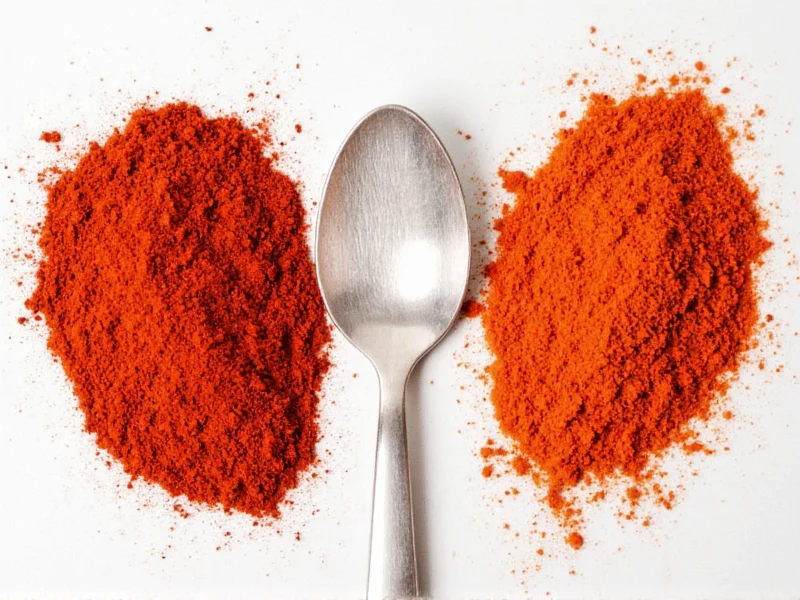Understanding the distinction between these two red pepper spices is essential for home cooks and professional chefs alike. While both originate from Capsicum annuum peppers, their processing methods and pepper varieties create dramatically different end products that serve unique purposes in the kitchen.
Origins and Production Methods
Paprika traces its roots to Central Mexico, where it was cultivated by indigenous peoples before spreading to Europe through Spanish explorers. Today, Hungary remains famous for its premium paprika varieties. The spice is made by drying and grinding various types of sweet or chili peppers. Depending on the region and pepper variety used, paprika can range from sweet and mild to moderately spicy.
Cayenne pepper, named after the city in French Guiana, comes specifically from elongated cayenne peppers. These peppers are typically dried and ground into a fine powder. Unlike paprika which can be made from multiple pepper varieties, authentic cayenne is produced exclusively from cayenne peppers, resulting in consistent heat levels across different brands.
Heat Level Comparison: Understanding the Scoville Scale
The most significant difference between paprika and cayenne is their heat intensity. This distinction becomes clear when examining their positions on the Scoville Heat Unit (SHU) scale:
| Spice Type | Scoville Heat Units | Heat Level Description |
|---|---|---|
| Sweet Paprika | 0-100 SHU | No detectable heat, purely flavorful |
| Hot Paprika | 500-1,500 SHU | Mild warmth with pepper flavor |
| Cayenne Pepper | 30,000-50,000 SHU | Intense, immediate heat sensation |
When considering the difference between paprika and cayenne heat level, cayenne is approximately 30-100 times hotter than even the spiciest paprika varieties. This dramatic difference explains why substituting one for the other without adjustment can ruin a dish.
Flavor Profiles and Culinary Applications
Beyond heat, these spices offer distinct flavor characteristics that determine their best uses in cooking:
| Characteristic | Paprika | Cayenne |
|---|---|---|
| Primary Flavor Notes | Sweet, earthy, slightly smoky, sometimes fruity | Sharp, intensely hot, with subtle fruitiness underneath |
| Color Contribution | Vibrant red hue without clouding dishes | Red color but can make dishes appear muddy |
| Best Culinary Uses | Coloring dishes, Hungarian goulash, deviled eggs, roasted vegetables | Spicy sauces, Cajun/Creole dishes, hot wings, Bloody Marys |
| When to Add During Cooking | Early in cooking to develop flavor | Late in cooking to preserve heat intensity |
Substitution Guidelines: Can I Use Paprika Instead of Cayenne?
Many home cooks wonder if they can substitute paprika for cayenne when a recipe calls for one but they only have the other. The answer depends on which direction you're substituting:
- Using paprika instead of cayenne: You'll get color but minimal heat. For every 1/4 teaspoon of cayenne, use 1-2 teaspoons of hot paprika plus a pinch of red pepper flakes for heat.
- Using cayenne instead of paprika: This requires extreme caution. For every 1 tablespoon of paprika, use just 1/8-1/4 teaspoon of cayenne, then adjust to taste.
When exploring what's the difference between sweet paprika and cayenne in substitution scenarios, remember that sweet paprika provides zero heat, so it cannot adequately replace cayenne without additional heat sources.
Nutritional Differences and Health Benefits
Both spices contain capsaicin (in varying amounts), vitamin A, and antioxidants, but their nutritional profiles differ due to processing methods and pepper varieties:
- Paprika is particularly rich in vitamin A (from beta-carotene), providing up to 43% of your daily value per tablespoon. It also contains vitamin E and carotenoids that support eye health.
- Cayenne contains higher concentrations of capsaicin, which has been studied for potential metabolism-boosting effects and pain relief properties. It also provides vitamin C, potassium, and B vitamins.
Understanding the paprika and cayenne pepper comparison from a nutritional standpoint helps explain why cayenne is often featured in metabolism-boosting supplements while paprika is valued more for its color and flavor contributions.
Storage Recommendations for Maximum Freshness
Both spices lose potency over time, but proper storage extends their shelf life:
- Store in airtight containers away from light and heat
- Keep in a cool, dark cupboard (not above the stove)
- Paprika maintains quality for 2-3 years; cayenne for 1-2 years
- Freeze in an airtight container for extended shelf life (up to 4 years)
When determining is cayenne pepper the same as paprika in terms of shelf stability, note that cayenne's higher oil content causes it to degrade faster than paprika.
Common Misconceptions Clarified
Several myths persist about these spices that deserve clarification:
- Myth: All paprika is mild. Fact: While sweet paprika is mild, Hungarian and Spanish varieties include hot paprika options.
- Myth: Cayenne and red pepper flakes are identical. Fact: Cayenne is a specific pepper type ground fine, while red pepper flakes contain multiple pepper varieties with seeds.
- Myth: The color indicates heat level. Fact: Deep red color in paprika comes from sweet peppers, not heat.
Practical Application Tips
When working with these spices in your kitchen:
- Always taste paprika before using—it ranges from sweet to hot
- Wear gloves when handling cayenne to avoid skin irritation
- Bloom paprika in oil to enhance its flavor before adding to dishes
- Add cayenne gradually and taste frequently—its heat builds quickly
- Pair paprika with complementary spices like garlic and onion powder
Mastering the difference between paprika and cayenne in recipes transforms your cooking by ensuring proper flavor balance and heat levels. Professional chefs understand that these aren't interchangeable ingredients but rather distinct tools in the spice cabinet.











 浙公网安备
33010002000092号
浙公网安备
33010002000092号 浙B2-20120091-4
浙B2-20120091-4